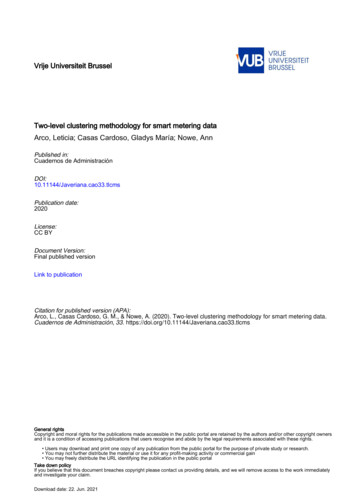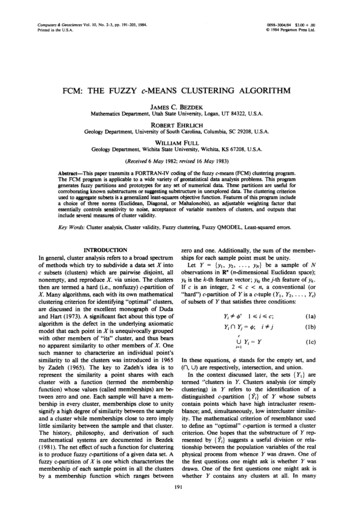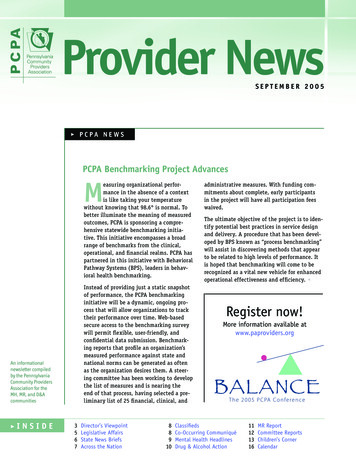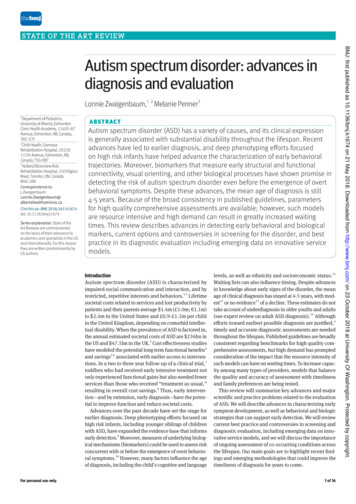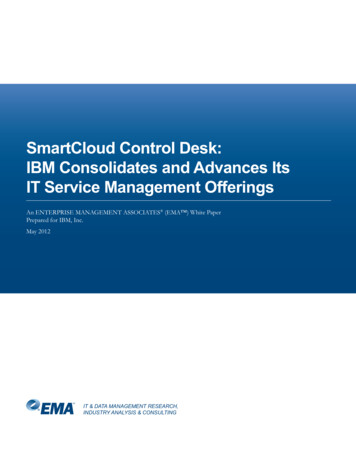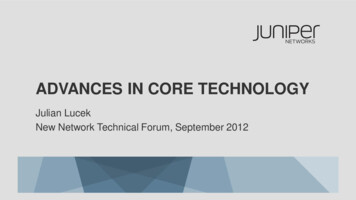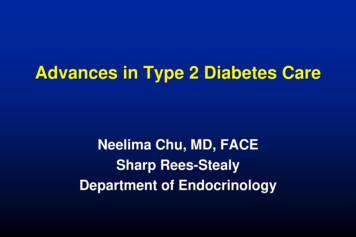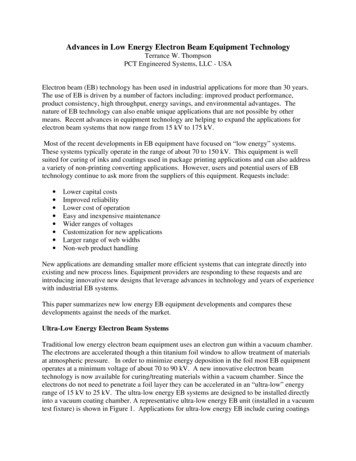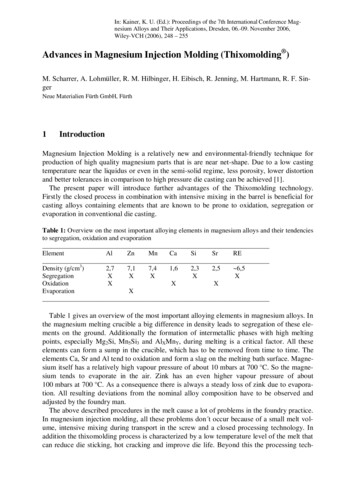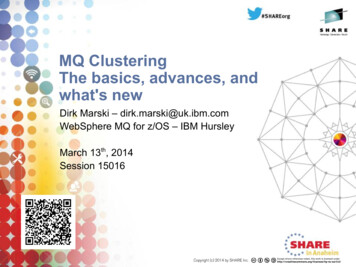
Transcription
MQ ClusteringThe basics, advances, andwhat's newDirk Marski – dirk.marski@uk.ibm.comWebSphere MQ for z/OS – IBM HursleyMarch 13th, 2014Session 15016
Agenda 2The purpose of clusteringDefining a clusterLifting the Lid on ClusteringWorkload BalancingFlexible topologies - routingFurther ConsiderationsRecommendationsWhat's New in 7.1/7.5
What are clusters? The term clusters means has different meaning for different people as there are a large number of technologies that usethe term and a large number of products that offer “clustering”. Clustering is usually associated with parallel processing or high availability technologies. There exist many different types of parallel processing architectures. The amount of symmetry between the processingnodes varies between architectures. Although WMQ clustering does provide a level of high availability, its raison d’etre is as a WMQ parallel processingfeature. The most symmetric systems are similar to SP2. These are essentially a set of identical processors (RS/6000) connectedtogether using a high speed switch which allows fast communication between the individual nodes. Systems like z/OS Parallel Sysplex consist of complexes of processors, each complex comprising numerous, but sametype processors. The complex is connected together using a coupling facility, which, as well as allowing high speedcommunication, also allows efficient data sharing. Most parallel architectures do not have this type of data sharingcapability. The most generalized parallel architectures involve processors of different types, running different operating systemsconnected together using different network protocols. This necessarily includes symmetric systems like SP2 and ParallelSysplex. A WebSphere MQ cluster is most similar to the most generalized parallel architecture. This is because WebSphere MQexploits a wide variety of platforms and network protocols. This allows WebSphere MQ applications to naturally benefitfrom clustering. WebSphere MQ clusters are solve a requirement to group queue managers together (i.e. to increase processing power ofthe WMQ network) whilst minimising the administration costs associated with WMQ queue manager intercommunication.
The purpose of clustering Simplified administration Large WMQ networks require many objectdefinitions Channels Transmit queues Remote queues Workload balancing Spread the load Route around failures Flexible connectivity Overlapping clusters Gateway Queue managers Pub/sub Clusters
How can we process more messages? It would be nice if we could place all the queues in one place. We could then add processing capacity around thissingle Queue manager as required and start multiple servers on each of the processors. We would incrementally addprocessing capacity to satisfy increased demand. We could manage the system as a single entity. A client applicationwould consider itself to be talking to a single Queue manager entity. Even though this is highly desirable, in practice it is almost impossible to achieve. Single machines cannot just haveextra processors added indefinitely. Invalidation of processor caches becomes a limiting factor. Most systems do nothave an architecture that allows data to be efficiently shared between an arbitrary number of processors. Very soon,locking becomes an issue that inhibits scalability of the number of processors on a single machine. These systemsare known as "tightly coupled" because operations on one processor may have a large effect on other processors inthe machine cluster. By contrast, "loosely coupled" clusters (e.g. the Internet) have processors that are more or less independent of eachother. Data transferred to one processor is owned by it and is not affected by other processors. Such systems do notsuffer from processor locking issues. In a cluster solution, there are multiple consumers of queues (client queuemanagers) and multiple providers of queues (server queue managers). In this model, for example, the black queue isavailable on multiple servers. Some clients use the black queue on both servers, other clients use the black queue onjust one server. A cluster is a loosely coupled system. Messages flow from clients to servers and are processed and responsesmessages sent back to the client. Servers are selected by the client and are independent of each other. It is a goodrepresentation of how, in an organization, some servers provide many services, and how clients use servicesprovided by multiple servers. The objective of WebSphere MQ clustering is to make this system as easy to administer and scale as the SingleQueue Manager solution.
Goals of Clustering Multiple Queues with single imageFailure isolationScalable throughputMQI applications to exploit clusters transparentlyDefinition through usage (MQOPEN)MQGET always local
Goals of Clustering Consider a client using the black queue that is available in the cluster on three serverqueue managers. A message is MQPUT by the client and is delivered to *one* of theservers. It is processed there and a response message sent to a ReplyToQueue on theclient queue manager. In this system, if a server becomes unavailable, then it is not sent any further messages.If messages are not being processed quickly enough, then another server can be addedto improve the processing rate. It is important that both these behaviors are achieved by existing MQI applications, i.e.without change. It is also important that the administration of clients and servers is easy.It must be straight forward to add new servers and new clients to the server. We see how a cluster can provide a highly available and scalable message processingsystem. The administration point in processing is MQOPEN as this is when a queue orqueue manager is identified as being required by an application. Note that only one message is sent to a server; it is not replicated three times, rather aspecific server is chosen and the message sent there. Also note that MQGETprocessing is still local, we are not extending MQGET into the network.
Repositories – full and partial Each queue manager in a cluster is a repository: It stores information about objects in the cluster Full repository (usually 2 per cluster): Stores all information about all objects in the cluster Partial repository: Only stores information that it needs to know about
WMQ Cluster ArchitectureCLUS.QCLUS.QPartial Repository QMs7QMA Reply applicationsQMB854Full Repository QMs693111102Partial Repository QMs Request applicationsQM1QM2
WMQ Cluster Architecture Reply queue manager hosts applications that send request and receive reply. Request queue manager hosts applications that receive request and sendreply. Let us walk through the flow of a message from a request queue manager to areply queue manager and the response message that is returned. We assumethat the request app has never used the queue providing the servicepreviously, and that the request app has not communicated with the requestapp previously. Clustering introduces a new architectural layer, the Full Repository and PartialRepository queue managers, purely for the sake of explanation. FullRepository queue managers are not separate queue managers (contrast toDNS servers), and their role is to serve as a global directory of queues andqueue managers in the cluster. There are a small number of these FullRepositories. Each request and reply queue manager have a PartialRepository. In practice, Full Repository queue managers often hostapplications too.
WMQ Cluster Architecture At MQOPEN, the queue manager to which the application is connecteddetects that this queue has not been used by this queue manager previously.The queue manager sends an internal message (1) requesting the location ofthe servers for the green queue and channel definitions to get to theseservers. The returned definitions (2) are installed on the request queuemanager, a channel is automatically defined to the reply queue manager (3). Similar processing occurs at the request side, to locate the requestor’sReplyToQueue manager. The most frequent method used by a reply app to send a response messageto a requestor is to use the routing information in the message descriptor,namely the ReplyToQ and ReplyToQMgr. The reply app's requirement isslightly different to the original request, since the originating application'sReplyToQ is normally private to its Queue manager, i.e. it is not visible to thewhole cluster. In this case the server needs to be able to locate theReplyToQMgr rather than the ReplyToQ.
WMQ Cluster Architecture This happens as follows. When an MQPUT1 or MQOPEN request is made to send amessage to a ReplyToQMgr for the first time, the queue manager sends an internalmessage (4) to the repository requesting the channel definition required to reach theclient. The returned definition (5) is used to automatically define a channel to the requestqueue manager (6) to get the message back to the request queue manager where localqueue resolution puts the message on the ReplyToQ. Finally, we see what happens when some attributes of a cluster queue or cluster Queuemanager change. One interesting case is the creation of a new instance of a clusterqueue manager holding a cluster queue being used by a request (7). This information ispropagated from the reply queue manager (8). The Full Repository propagates thedefinition to the other Full Repository (9) and the Full Repository propagates it to anyinterested request QMs through the repository network (10), allowing this new instanceto be used during an MQOPEN, MQPUT or MQPUT1 call (11). Note that channels are only automatically defined once on the first MQOPEN thatresolves to a queue on the remote queue manager, not for every MQOPEN or MQPUT.
New in V7 - Pub/sub ClustersSUBPUB For distributed pub/sub Based on clustered topicobjects Hosted on one or more queuemanagers in the cluster Based on clustering for objectauto-definition All to all queue manager connectivity Channel auto-definition on firstcluster topic definitionTOPICSUB How large? 100 queue managersSUBPUB
New in V7 - Pub/sub Clusters WebSphere MQ V7 introduces Pub/sub Clusters which areused for distributed pub/sub, allowing publishers to sendpublications to remote subscribers. Pub/Sub clusters use the underlying clustering features toprovide automatic connectivity between queue managers. The point of control for Pub/sub clusters is the topic objectwhich can be administratively shared in the cluster, just asqueues can be shared in a cluster. We will look at this in more detail a little later.
Cluster configuration
Resource definition for a PartialRepositoryDEFINE CHANNEL(TO.QM1) CHLTYPE(CLUSRCVR) TRPTYPE(TCP)CONNAME(MACHINE1.IBM.COM) CLUSTER(DEMO) CLUSRCVR definition provides the information to the cluster that allows other queuemanagers to automatically define sender channelsDEFINE CHANNEL(TO.QM2) CHLTYPE(CLUSSDR) TRPTYPE(TCP)CONNAME(MACHINE2.IBM.COM) CLUSTER(DEMO) CLUSSDR definition must direct the queue manager to a Full Repositorywhere it can find out information about the clusterDEFINE QLOCAL(PAYROLLQ) CLUSTER(DEMO) Queues can be advertised to the cluster using the CLUSTER() keywordDEFINE TOPIC(SPORTS) TOPICSTR(/global/sports) CLUSTER(DEMO) and so can Topics
Resource definition for PartialRepository QM1 The cluster channels are the backbone of the cluster, and it is worth taking a little time to understandwhat they are used for. The use varies slightly depending on whether the queue manager is going tobe used as a Full Repository or a Partial Repository.Partial Repository To get a Partial Repository queue manager running in the cluster, you will need to define a clustersender channel and a cluster receiver channel. The cluster receiver channel is the most important of the two as it has 2 roles. (1) It is used as astandard receiver channel on the queue manager on which it is defined. (2) The information itcontains is used by other queue managers within the cluster to generate automatically definedcluster sender channels to talk to the queue manager on which the cluster receiver is defined. It isfor this reason that the cluster receiver channel definition contains a number of attributes usuallyassociated with sender channels such as the conname. The cluster sender channel is used to point the Partial Repository at a Full Repository queuemanager from which it can then find out about other Full Repository queue managers and resourcesin the cluster. The cluster sender channel on a Partial Repository queue manager could beconsidered to be a boot-strap. Once the Partial Repository has exchanged some initial informationwith the Full Repository, the manually defined cluster sender channel is no longer required, but canbe used to preferentially choose a Full Repository to publish and subscribe for cluster resources asmentioned previously.
Resource definition for Full RepositoriesFull Repository A full repository is created by issuing alter qmgr(CLUSNAME) On a Full Repository, the role of the cluster receiver channel is the same :- it provides the informationrequired by other queue managers in the cluster to talk to the Full Repository. The difference is in the use ofthe cluster sender channels. Manually defined cluster sender channels must be used to link all of the FullRepositories within the cluster. For the Full Repositories to communicate correctly, these channels need toconnect the Full Repositories into a fully connected set. In a typical scenario with 2 Full Repositories, thismeans each Full Repository must have a cluster sender channel to the other Full Repository. These manualdefinitions mean that the flow of information between the Full Repositories can be controlled, rather thaneach one always sending information to every other Full Repository. The 2 key points to remember are: The Full Repositories must form a fully connected
WebSphere MQ V7 introduces Pub/sub Clusters which are used for distributed pub/sub, allowing publishers to send publications to remote subscribers. Pub/Sub clusters use the underlying clustering features to provide automatic connectivity between queue managers. The point of control for Pub/sub clusters is the topic object which can be administratively shared in the cluster, just as .


